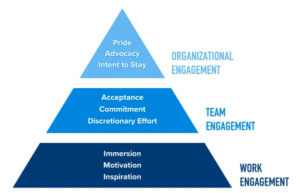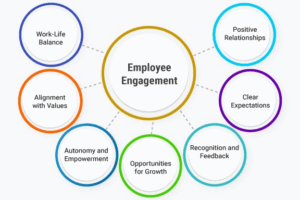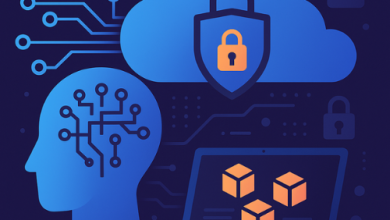
Employee engagement has become a key differentiator for global brands navigating a rapidly changing business landscape. According to the Gallup State of the Global Workplace report, only 23% of employees worldwide feel engaged at work, yet companies with highly engaged workforces outperform their peers by up to 21% in profitability. This shift reflects a broader transformation, brands are no longer defined solely by what they sell but by the emotions they evoke and the experiences they create.
The often-overlooked people who build, represent, and deliver services now hold the power to shape a brand’s public perception. In this human-centric era, employee engagement has evolved from an HR initiative into a business-critical asset, fueling not just internal culture, but also external trust, loyalty, and long-term success.
Let’s analyze the correlations of engagement and branding through the lens of leading companies, insights, and trends.
The Rise of AI in Employee Engagement
As remote and hybrid work become the norm, companies are turning to AI to redefine employee engagement. From intelligent onboarding systems to sentiment analysis tools that gauge team morale in real-time, artificial intelligence is helping leaders make data-backed decisions to enhance culture, productivity, and brand alignment. These technologies not only boost internal satisfaction but also directly influence how brands are perceived externally. AI transforms disengaged teams into empowered brand ambassadors by personalizing the employee journey, leading to more trust, loyalty, and advocacy from both staff and customers.
Why Tech-Enabled Engagement Is Essential for Brand Identity
Branding is not just ads, logos, or a catchy slogan. It is how people perceive an organization based on what they hear from people or the company employees themselves, their past interactions, and experiences.
A dispersed workforce severely cripples brands seeking to maintain a dynamic image. Reports from Gallup indicate engagement correlates with profitability and customer loyalty: a 21% increase in revenue and 17% in customer retention respectively. This is not a coincidence. Employees who are engaged actively champion their brands while delivering top-notch interactions to customers and aligning their vision with the company’s mission.
The Digital Employee-Customer Connection
Brand ambassadors are engaged employees. Customer support, digital marketing, logistics, sales, and every department in between is impacted by their enthusiasm. The customer experience seems to change totally when they are served by an upbeat employee. Purpose-driven workers are far more likely to:
- Offer better customer service
- Build authentic customer relationships
- Solve problems more efficiently
- Promote company values through everyday interactions
Translating enhanced word-of-mouth promotion and online ratings, and bolstered community engagement all contribute to a brand that is greatly trusted and recognized.
Tech-Driven Engagement Strategies That Strengthen Your Brand
Now let’s explore some brand perception changes that arise from employee engagement and are supported by research.
1. Turning Employees into Digital Brand Advocates with AI
The brand is automatically exploited through its advertising without the employer’s expense when they trust and believe in the brand. Employees talk about the company with pride which, in today’s age, can be showcased in almost all social media sites, not forgetting LinkedIn, Glassdoor, and even casual conversations. Trust is built through this level of advocacy at an era of skepticism, with people believing real employee posts over polished adverts.
As we see from Edelman’s Trust Barometer, they claim that company related information is trusted more coming from employees than CEOs and any media outlets.
2. AI and Consistency Across Customer Touchpoints
Engaged employees tend to be more aligned with company value and messaging. This guarantees that there is a coherent customer experience across the board whether it is with your technical support staff or a sales representative. Cohesion supports brand reputation and enhances retention.
3. Building Employer Branding with Analytics and Transparency
Current job applicants investigate potential employers prior to submitting their applications. With tools like Glassdoor, LinkedIn, or Indeed, gauging organization morale has been simplified. Alongside strong employee engagement, the same company used to bolster its workforce becomes a sought-after brand signaling people-first ethos.
4. Empowering Innovation Through AI and Collaboration Tools
With employees who are included, emotional investment increases alongside motivation to contribute. New ideas and ownership are presented alongside suggestion making without care of ridicule. This further inclines novel concept generation, which is a requirement in modern brands.
Take, for example, Google and Salesforce who are admired not only for their products but also for the internal innovative and collaborative creative culture that is unique and open.
5. Tech-Backed Crisis Response and Brand Trust Recovery
Engaged employees are the ones likely to be at the organization’s side during a PR crisis or recession. Their trust in leadership alongside brand credibility is reinforced through brand cohesion-enhanced damage control. Cohesion on the inside can prevent brand damage and hasten recovery.
Tech-Forward Companies That Get Employee Engagement Right
Salesforce
Salesforce regularly features on “Best Places to Work” lists. But even more relevant is how Salesforce employs brand management by utilizing its workforce. Through prioritizing employee wellness, transformational leadership, and fulfilling work, Salesforce transforms its employees into advocates for the brand. This people-first strategy is evident because they also maintain good relations with their customers and enhance brand equity.
Zappos
Zappos built its brand around one thing: customer service. This would be impossible without an engaged and empowered team, though. Zappos fosters a customer experience engine by encouraging employees and prioritizing happiness at work. This brand has become synonymous with service excellence due to their flourishing service-oriented culture.
Contrast
At Contrast, customer satisfaction is a company-wide priority. Support isn’t limited to one team—engineers handle integration and technical questions, accounting resolves billing issues, and sales, HR, and customer care all pitch in when needed. Employees take pride in working for a company that values happy customers as much as they do. This shared commitment shows: nearly half of Contrast’s G2 reviews highlight outstanding customer service. The result is a workplace where engaged, motivated employees drive not only user satisfaction but also the growing success of the brand.
How to Sync Brand Strategy with AI-Driven Employee Engagement
Separating brand development and employee engagement is a no-go. Take these steps to make sure both concepts are aligned:
1. Define Your Brand Purpose Clearly
Employees need a clear purpose to feel motivated. Companies having an aligned mission tends to make one feel more connected and motivated especially if it is communicated well.
As an example, Patagonia isn’t just selling its environmental mission to the customers. It is a core part of the experience their employees go through – from benefits to daily practice.
2. Invest in Internal Communication
Make certain that employees stay updated. Provide information regarding updates, objectives, milestones, and issues. When employees feel they are in the loop, they tend to perceive that their contribution is important and are willing to promote the business publicly.
3. Create a Feedback Culture
For employees surveyed by Salesforce, feeling listened to increases best performance by 4.6 times. Make sure everyone’s voice is heard through the use of anonymous feedback tools, town hall meetings, and open door policies.
4. Train for Brand Alignment
Teach all new and current employees the specific brand components such as values and tone. From social media to customer service, every single role should understand how they are part of brand storytelling.
5. Recognize and Reward Aligned Behavior
Help employees who exhibit your brand attributes. Participation motivates following actions because it incentivizes recognition fostering engagement.
Why 2026 Will Be the Year of Human-AI Cultural Synergy
Modern working tools like AI paired with hybrid work schedules and the influx of Gen Z into the workforce has turned the working environment upside down. Workers no longer accept a paycheck as the only benefit. They actively pursue identity, community, and self-evolution. Stronger cultures utilizing these areas enhance their reputation and nurture their needs.
In addition, as brands become more relatable and open, your internal culture will also be externally visible. Through social media, public interviews, or reviews, your employees have a hand in shaping your brand voice. It’s time to harness that power thoughtfully.
Final Thoughts
The most potent brands will be those who thrive from within. Engaged employees are no longer just an HR number; rather, they are a strategy for marketing, brand identity, and growth. When you work to improve your people, you are creating the most credible and lasting brand image imaginable.







